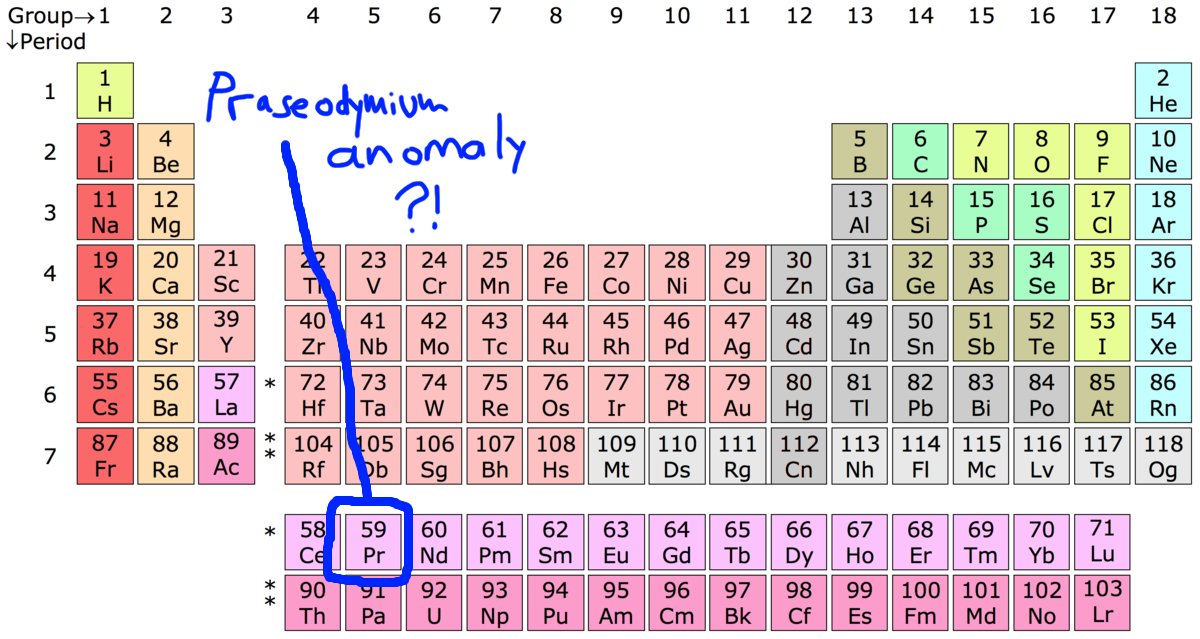Here's a thread about a mineralogical oddity (and a new paper).
So you've probably heard about cerium and europium anomalies, but did you ever hear about praseodymium anomalies?
Read on!
So you've probably heard about cerium and europium anomalies, but did you ever hear about praseodymium anomalies?
Read on!
It all started when I asked a mineralogist friend who is also up to date on IMA nomenclature issues, why do we have to call the mineral Ce⁴⁺SiO₄ "stetindite-(Ce)", if it has Ce⁴⁺ in it. It's not like we will ever have La⁴⁺SiO₄ (for example) because La⁴⁺ doesn't exist!
He said, well there are two more rare earths than be can tetravalent: praseodymium and terbium. So it keeps the option of stetindite-(Pr) and stetindite-(Tb) open. Which makes sense - the Pr-oxide we have in the lab is Pr₆O₁₁ - a mixed trivalent and tetravalent oxide.
So we thought - where will we be able to find natural Pr⁴⁺? It probably requires conditions too oxidising for them to be plausible in nature. We turned to experiments - and we looked at zircon.
Zircon is probably the most famous mineral that can easily take up Ce⁴⁺ in oxidising conditions, so it will also take any Pr⁴⁺, if it's there.
We checked zircons grown in a high temperature Pt-PtO₂ oxygen buffer, essentially a gazillion times more oxidising than anything which can reasonably happen in nature.
It has a bit more Pr than expected, but not really distinguishable from uncertainty.
So, inconclusive.
It has a bit more Pr than expected, but not really distinguishable from uncertainty.
So, inconclusive.
Then, we thought that stetindite itself might have a Pr anomaly! We contacted the Norwegians who found it first, then we found some in our own rocks here in Australia. And we did find that in some cases, Pr is more than it should be!
In the Australian rocks, we even found complementary positive and negative Pr anomalies that followed the behaviour of Ce.
Next, plot some REE data of cerianite (CeO₂) from the literature, just to see that there are some massive Pr anomalies there, that no one ever noticed because the were obscured by the even greater Ce anomaly next to it.
Even though anomalies are nice, this still wasn't conclusive 100% evidence that Pr⁴⁺ was the culprit. Maybe it was something else causing the anomalies?
So we took one of the stetindites to the XAS beamline at the @ausynchrotron and with the help of @GeoloJess_ we were able to spectroscopically detect tetravalent Pr in a natural material, for the first time!
So we wrote something about it, and it's published now:
"Quadrivalent praseodymium in planetary materials"
http://www.minsocam.org/processIP_new.lasso?file_name=AM105P1802 or https://doi.org/10.2138/am-2020-7325
Out in the December issue of American Mineralogist.
"Quadrivalent praseodymium in planetary materials"
http://www.minsocam.org/processIP_new.lasso?file_name=AM105P1802 or https://doi.org/10.2138/am-2020-7325
Out in the December issue of American Mineralogist.

 Read on Twitter
Read on Twitter








